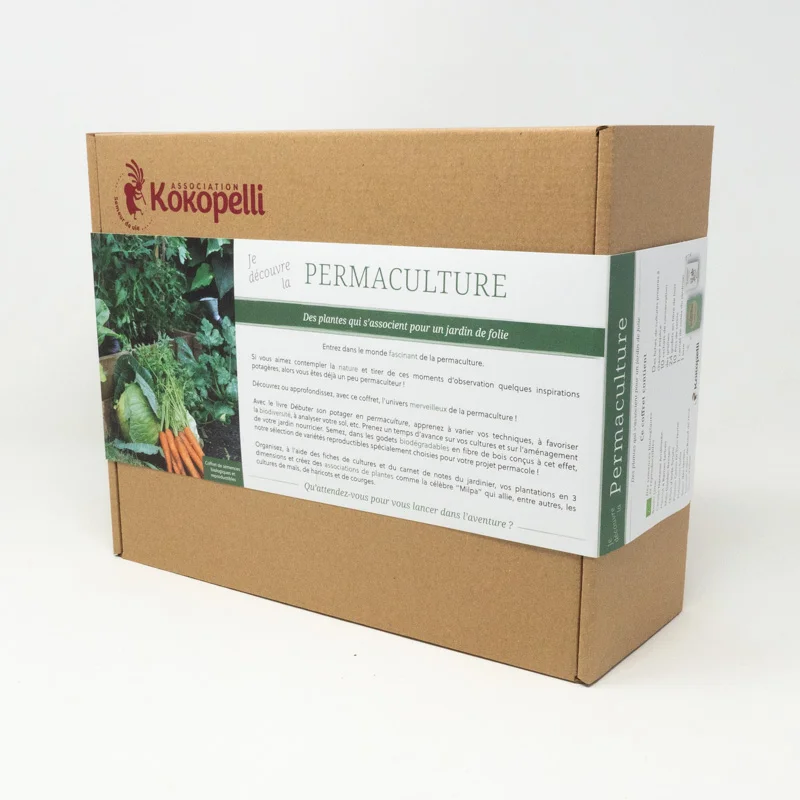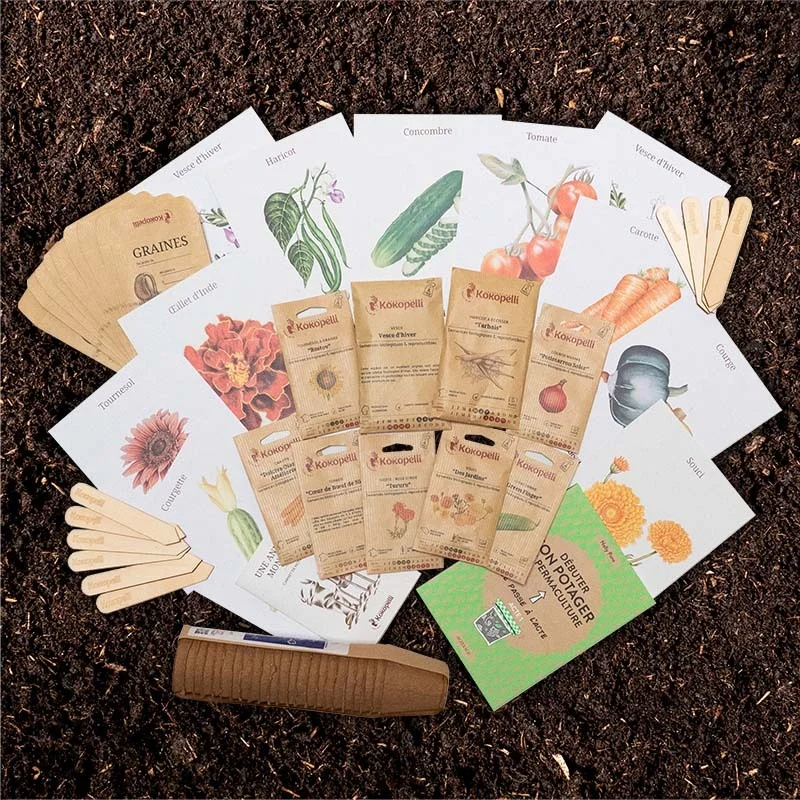Seed box - Permaculture
Permaculture is a complete concept inspired by nature. What if practicing using permacultural gardening methods became possible? This box of organic, reproducible seeds contains everything you need to move from theory to practice, including :
- 10 organic seed packets
- 10 growing instructions for each species
- The book Débuter son potager en permaculture (in French only)
- 24 wood fiber cups 6x6cm
- 10 seed storage bags
- 1 gardener's notebook
** Erratum: some varieties have not been updated at the time of printing. The composition of the box is updated on this product sheet **.
What does the Permaculture Seed Box consist of?
It's made up of a selection of 10 packets of organic, reproducible seeds. These varieties have been selected for the diversity they bring to the vegetable garden, as well as their complementarity.
The book Débuter son potager en permaculture (Starting a Permaculture Vegetable Garden) simply explains, with the help of its illustrations, how to put the main principles into practice, such as analyzing the soil, making cultivation mounds, creating a good compost, associating species, and so on.
The wood-fiber cups are biodegradable, so there's no need to take the seedling out of the cup. Simply plant it directly into the hole when planting.
Seed storage bags are ideal for storing harvested seeds after the season. Stored in a box or carton, they can be resown next year.
Crop sheets are a gold mine of generic information on the species, and a valuable ally in cultivating varieties.
The gardener's notebook provides a guided record of a season in the vegetable garden. Sowing calendar, garden design plan, month-by-month crop list - creativity and free expression are welcome!
The organic varieties in the permaculture box?
Originally from East Africa, this population produces single yellow or orange flowers on tall plants.
The scent given off by the leaves repels certain insect pests such as aphids and attracts other, more useful insects such as butterflies and hoverflies. As for the root, it secretes a substance that is thought to inhibit nematodes and whiteflies.
This variety produces smooth, cylindrical, thick roots. Their orange skin contains little heart. They keep very well over winter.
The Tarbais bean is a very old variety with pods around 20 cm long. They offer melt-in-the-mouth beans, traditionally used in the preparation of cassoulet.
This variety can grow up to 2.50 m tall.
- [Green Finger Cucumber](This variety, resistant to most cucumber diseases, produces an abundance of green fruit up to 20 cm long).
This old variety produces 1 to 2 spikes about 15 cm long, made up of 8 rows of yellow seeds. The milky phase is short, so pick as soon as you can.
This old variety reaches 2 m in height. It produces a thin, straight stem bearing a single yellow flower whose black seeds are very interesting for making oil.
The flower petals enhance salads, and the seeds are very popular with birds.
This variety, the earliest of all the pumpkin varieties, produces small orange-red fruits weighing around 1 kg with an excellent sweet taste.
"Solor" is a biodynamic research variety. It was selected by Bart Vosselman of De Bolster, Holland.
This population, originally from East Africa, produces single yellow or orange flowers on tall plants.
The scent released by the leaves repels certain insect pests such as aphids and attracts other, more useful insects such as butterflies and hoverflies. As for the root, it secretes a substance that is thought to inhibit nematodes and whiteflies.
From spring to autumn, this variety offers a mixture of orange and yellow flowers, single or double, which are melliferous, tinctorial and have many medicinal virtues.
Marigold is also known as Calendula. And the origin of this name comes from the fact that it blooms all year round, during the calendas (1st day of the month in Roman times) of each month.
The Coeur de Bœuf de Nice tomato is an old-fashioned variety that produces red "coeur de bœuf"-type fruits weighing 200 to 300 g.
This species is an excellent green manure and winter forage. It retains nitrogen and roots deeply, leaving a very good soil structure.
When to start sowing in the garden?
You can sow all year round, depending on your climate, equipment and varieties. The most important period is spring, when seeds are generally sown between March and the end of April. There are other sowing periods, such as summer or autumn for winter harvests. However, they require a certain amount of experience to cope with the cold.
All our bags indicate the sowing period, the container and all the information needed for good germination.
What is permaculture?
Permaculture is a way of life in which mankind, inspired by nature, creates an environment conducive to self-fulfilment within a natural ecosystem.
Permaculture is more than just a method of producing food; it's a global approach in which man is seen as a promoter of biodiversity.
The 3 pillars of permaculture are: caring for nature, caring for people and sharing resources equitably.
A few methods:
- Design: thinking about the layout beforehand, so as to connect elements in the best possible way.
- Multifunctionality: an element must have several functions and contribute to the surrounding elements.
- Species diversification: the more different species there are, the more individual properties (resistance to disease, climatic conditions) will enhance the ecosystem and make it resilient.










